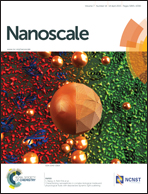How to choose a precursor for decomposition solution-phase synthesis: the case of iron nanoparticles†
Abstract
The decomposition of organometallic compounds as precursors has revolutionized the synthesis of nanoparticles in solution. However, effective control of size and size distribution of iron nanoparticles has remained challenging due to the high reactivity of iron towards oxygen or oxygen-containing materials. Reported is a decomposition study that shows how metal to ligand bonding and symmetry of the compound can be manipulated to control the size and size distribution of iron nanoparticles in the 6–16 nm range. [Fe(η5-C6H3Me4)2] was found to be the optimal precursor with a narrow decomposition temperature range due to its symmetry and the low bond dissociation energy of the ligands from the Fe(II) center. The precise control of nanoparticle size has enabled the tuning of magnetic properties from superparamagnetic to soft-ferromagnetic desirable for a wide range of biomedical applications.


 Please wait while we load your content...
Please wait while we load your content...